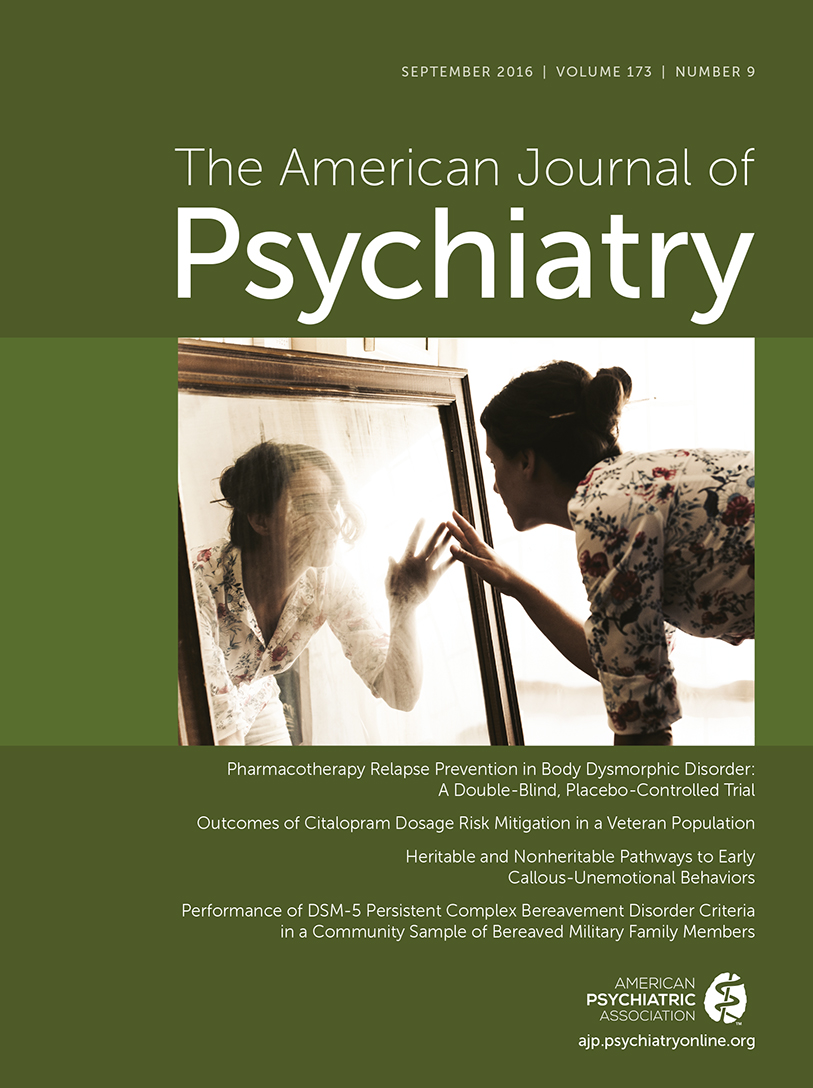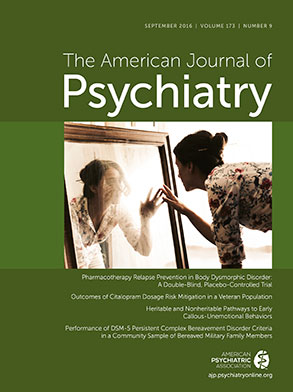Conduct problems are a common reason for a childhood referral to mental health and educational services and represent a substantial public health cost (
1). Callous-unemotional behaviors, indicative of lack of empathy and remorse, characterize children who are at risk of developing persistent conduct problems (
2). Previous research indicates that callous-unemotional behaviors are moderately to highly heritable (
3) and that conduct problems that co-occur with high levels of callous-unemotional behaviors may be more heritable than conduct problems that do not co-occur with these behaviors (
4). In other words, children with conduct problems and callous-unemotional behaviors may be genetically vulnerable to developing persistent antisocial behavior. However, for complex behaviors genetic vulnerability does not equal destiny for developing a particular outcome; there are no genes that directly code for callous-unemotional behavior. Genes code for proteins that influence characteristics such as neurocognitive vulnerabilities that may in turn increase risk for developing callous-unemotional behaviors and conduct problems. Although an individual’s genome likely limits a “range for phenotypic expression” (so-called reaction norm), it does not prespecify how an individual will turn out. The specific developmental trajectory of any individual is determined by a complex interplay between genetic propensities and other factors that constrain how those genetic propensities are expressed at different levels of analysis, and throughout different developmental stages. Genetic variants that are associated with callous-unemotional behaviors (once they are reliably ascertained) are likely to confer advantages as well as disadvantages, depending on the environmental context. The challenge for researchers and practitioners alike is to uncover the mechanisms through which individuals with different genetic and environmental vulnerabilities arrive at maladaptive or better-adjusted outcomes. Parenting may represent one of these mechanisms.
Harsh and negative parenting has been associated with higher levels of callous-unemotional behaviors, whereas a warm parental style has been associated with lower levels of callous-unemotional behaviors in children (
5). But it is not self-evident that such parenting correlates of callous-unemotional behaviors reflect purely environmental causal influences of parenting on behavioral development. Parents with genetic risk factors for antisocial behavior are likely to display parenting behaviors in line with these risks (e.g., harsh parenting) and also pass these genetic risk factors, which are likely to influence conduct problems and callous-unemotional behaviors, to their offspring. This means that part of the association between less than optimal parenting strategies and conduct problems/callous-unemotional behaviors may represent a genetic confounder (passive gene-environment correlation), which has been demonstrated for antisocial behavior (
6). We also know that children with conduct problems and callous-unemotional behaviors are extremely challenging to parent. They typically show diminished empathy for others, display less remorse, manipulate others, and do not seem to want to please adults or readily show affection to others. It is therefore likely that the parenting reactions they evoke are different from those that less challenging children evoke, and recent research suggests that this is the case (
7) (evocative gene-environment correlation).
To date, only two genetically informative longitudinal studies have investigated parenting and development of callous-unemotional behaviors (
8,
9). Results from the first of these studies, capitalizing on a monozygotic twin differences design, suggest that the association between harsh and negative parenting and higher levels of callous-unemotional behaviors in children may, at least in part, reflect genetic vulnerability within families (
8). This could reflect either a shared genetic vulnerability for poor parenting and callous-unemotional behaviors or an effect of callous-unemotional behaviors in evoking negative or harsh parenting.
Complementing and extending this work, a highly informative and exciting adoption study by Hyde and colleagues in this issue of the
Journal (
9) demonstrates both the impact of biological risk for conduct problems and callous-unemotional behaviors and a clear indication that protective environmental factors are able to moderate the expression of that risk. In the Hyde et al. study, a total of 561 adopted children and their adoptive and biological families from the Early Growth and Development Study were assessed longitudinally. Adopted children were assessed on callous-unemotional, oppositional, and attention-deficit behaviors at age 27 months. Severe antisocial behavior was assessed in biological mothers as an index of biological risk, which may reflect genetic risk totally or partially. Adoptive mothers’ positive reinforcement was assessed when the child was 18 months old. The main findings from longitudinal structural equation modeling showed that 1) severe antisocial behavior in the biological mother predicted callous-unemotional behaviors in the child (β=0.16, p<0.01) but not attention-deficit and oppositional behaviors; 2) positive reinforcement by the adoptive mother exerted a protective influence on callous-unemotional (β=−0.19, p<0.01) and oppositional behaviors (β=−0.15, p<0.01); and 3) severe antisocial behavior in the biological mother did not predict callous-unemotional behaviors if the adoptive mother engaged in a high degree of positive reinforcement toward the child (β=0.01, p>0.90). These findings are extremely encouraging, as the biological risk for early callous-unemotional behaviors appeared to be completely buffered by positive reinforcement from the adoptive mother.
Despite the excitement that these findings should naturally generate, key challenges regarding their potential for translation should be addressed. First, the long-term protective benefits of positive reinforcement on the development of callous-unemotional behavior in vulnerable children needs confirmation. Recent studies have highlighted the importance of genetic effects on long-term developmental trajectories of conduct problems, whereas environmental influences tend to be short-term (
10). Therefore, the observed protective benefits of environmental influences, including positive reinforcement in toddlerhood, may not be maintained throughout childhood, and other developmentally specific genetic and environmental factors may take over. These include genetic factors pertaining to the maturation of those brain areas involved in planning, impulse control, and complex social interactions, as well as developmentally specific environmental risk factors, such as peer relationships and neighborhood factors.
Furthermore, as Hyde et al. point out, it is important to bear in mind that parents in adoptive families are typically highly motivated to undertake the challenges of parenting and are also often well resourced. By contrast, in biological families, parents of children with callous-unemotional behaviors are likely to have a host of genetic and contextual risk factors, which can pose challenges for promoting interventions that seek to increase positive reinforcement behaviors toward the child—particularly if the child is challenging. Therefore, the efficacy of such interventions in biological families, as well as the size and the duration of any beneficial impact on callous-unemotional behaviors and conduct problems, still must be established.
In sum, Hyde et al. (
9) have made an important contribution to our understanding of how biological and environmental risk interact in shaping the early development of callous-unemotional behaviors. Follow-ups in the Early Growth and Development Study and other genetically informative studies will hopefully shed further light on the long-term significance of these findings and bring us closer to a causal understanding of risk and protective pathways to callous-unemotional behavior and conduct problems across different development periods.
Acknowledgments
Dr. Viding is a Royal Society Wolfson Research Merit Award holder.

